Is your flower game SUFFERING? Choosing the right WHITE FLOWERING BUSH can be TRICKY. There are so many varieties and shapes to choose from. Finding the perfect one for your garden can be akin to locating a needle in a HAYSTACK.
Or as hard as finding a recent movie without WOKE MESSAGING. But worry not. We’ll help you find something for you!
Looking for your friendly neighborhood gardening experts? You are in the RIGHT PLACE!
We have YEARS OF EXPERIENCE with shrubs. Not to brag or anything, but we UNDERSTAND what makes them tick, or SHRUB – or whatever those bushes do.
So you TRUST US with your bushes. The ones in the GARDEN, of course! Hahaha.
Think of it like DATING – you have your preferences, needs, and deal breakers. But unlike online dating sites, No Fake Profiles here, folks!
We dig DEEP into which varieties match your personality until we find “THE ONE.” And who knows? Maybe you’ll even PUT A RING on that flower stem someday 😉
We’ll be talking about 16-blooming white flowering bushes!
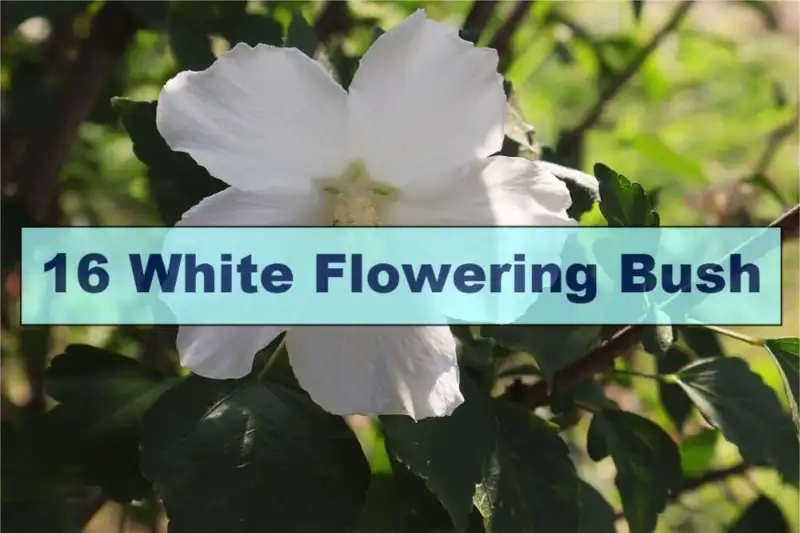
16 White Flowering Bush
Here is a list of 16 gorgeous white flowering bushes to consider.
1. Oakleaf Hydrangea
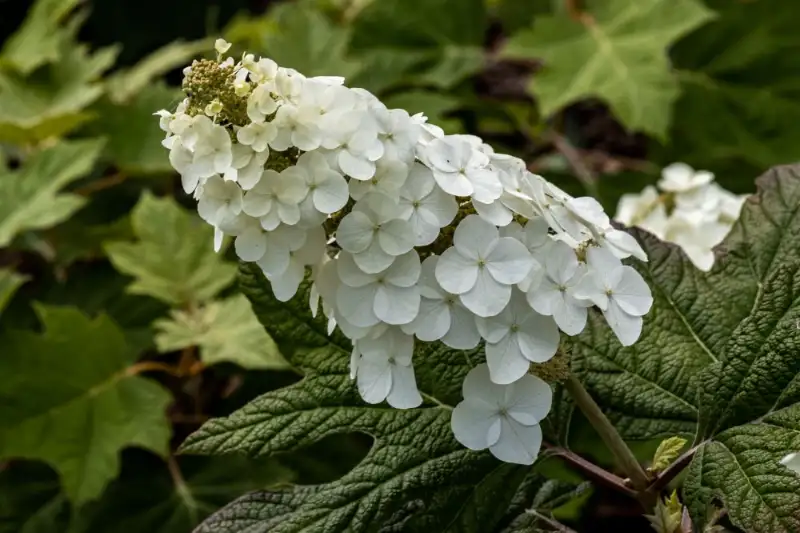
The Oakleaf Hydrangea is an evergreen bush with LARGE WHITE FLOWERS. I use these FRAGRANT BLOOMS to bring my garden to life. They add a splash of beauty and fragrance during the warmer SUMMER MONTHS.
I think of it as adding some Chanel No. 5 to my garden.
I like to use them as year-round hedges, shrubs, borders, or accent plants. They have attractive foliage, after all.
Hardiness: USDA zones 5–9.
Light exposure: full to partial sun.
Blooming season: repeated in summer.
Size: 3 – 12 feet tall (1-3.6 m) and up to 4 feet in spread (1.2m).
Soil requirements: moist soil, well-drained soil and fertile loam or sand-based soil. Need a slightly acidic pH. Keep it humid watering regularly.
Tips:
I provide plenty of MOISTURE and MORNING SUN for the best possible growth. You should also consider adding fertilizer to these babies during spring and fall. I always go for the BALANCED FERTILIZER.
2. American Elderberry
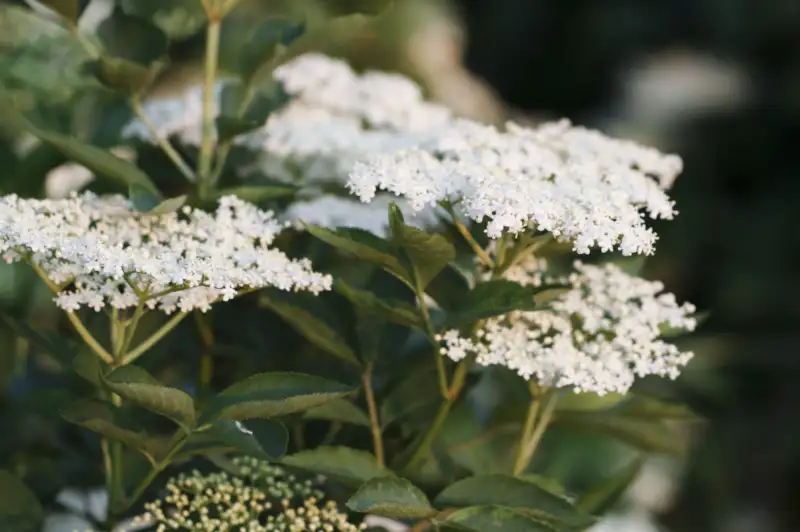
American Elderberry is a white flowering shrub. Its FRAGRANT, SHOWY WHITE FLOWER clusters tell you it’s a treat. This deciduous shrub grows QUICKLY. By the time you blink twice, you have an unruly bush.
The elderberries are edible; you can use them on your Ratatouille time to make syrups or jams. Also, the LEAVES of this plant can also be used to make MEDICINAL TEA. You can use it to help soothe sore throat symptoms or relieve headaches.
Hardiness: USDA zones 3 to 9.
Light exposure: full to partial sun.
Blooming season: repeated from early summer
Size: 6 to 12 feet tall (1.8 – 3 m) and up to 15 feet in spread (4.5m).
Soil requirements: Well-drained, moist soil and fertile loam, clay, or sand-based soil. Need a pH from neutral to acidic. May suffer if the soil becomes too dry or acidic.
Tips
Consider planting MULTIPLE of these white flowering shrubs near each other. This will help them use CROSS-POLLINATION with different varieties resulting in BETTER BERRIES.
3. Mock Orange
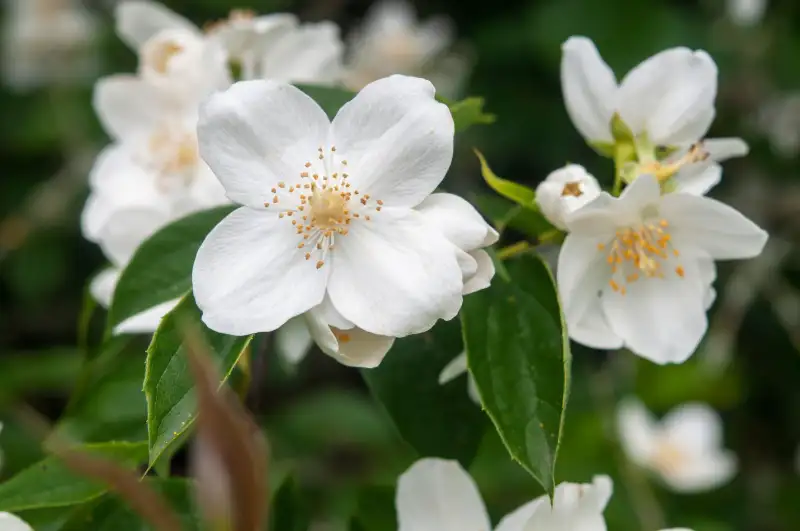
Mock Orange is a white flowering, EVERGREEN SHRUB. Its fragrant flowers form in small clusters and are surrounded by DARK GREEN FOLIAGE.
Mock Orange bushes keep their lush look all year long thanks to the GLOSSY nature of their LEAVES. That’s just like my girlfriend.
And I use them for privacy hedges or plant them as borders around flower beds and pathways. Think of them as nature’s way of saying, “Mind your business.”
They enhance my outdoor spaces with their SWEET FRAGRANCE
and BRIGHT BLOOMS! The smell alone will have your nose doing a HAPPY DANCE.
Hardiness: USDA zones 3–8.
Light exposure: full to partial sun.
Blooming season: repeated from early spring to summer.
Size: 5-6 feet tall (1.5 – 1.8 m) and up to 12 feet in spread (3 -4m).
Soil requirements: Well-drained, moist soil and fertile loam or sand-based soil. Need a slightly acidic pH. Keep it humid watering regularly.
Tips
I prepare the soil before planting by adding ORGANIC MATTER to INCREASE DRAINAGE. Also, I space and water them thoroughly AFTER TRANSPLANTING them for the best results.
4. Azaleas
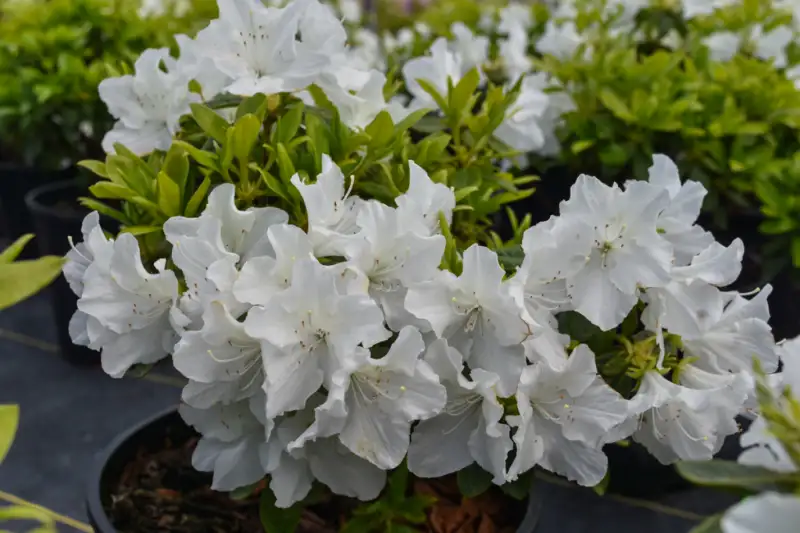
Azaleas is a WHITE FLOWERING SHRUB. Depending on the variety, they can be either EVERGREEN or DECIDUOUS SHRUBS. It’s like a plant chameleon – pick a side!
This NATIVE SHRUB also produce HIGHLY FRAGRANT flowers. It’s like the plant version of your favorite car perfume –minus the CHOKING HAZARD.
The variety also determines the intensity of the smell in the FLOWER CLUSTERS. So choose wisely if you want to impress your guests or neighbors.
But finding your neighbor smelling your bushes is a LITTLE WEIRD. Their EASY PROPAGATION makes them adaptable as hedges, providing structure throughout the year.
Hardiness: USDA zones 5-9.
Light exposure: partial shade.
Blooming season: repeated from mid or late spring to early summer.
Size: 3 -6 feet tall (0.91 – 1.83 m) and up to 4 feet in spread (1.22 m).
Soil requirements: well-drained, moist soil and fertile loam or sand-based soil. Need a slightly acidic pH. Keep it humid, watering regularly.
Tips
You should plant your babies in SPRING or FALL. You can also use PEAT MOSS and SULFUR to reduce the soil pH.
5. Laurel Cherry
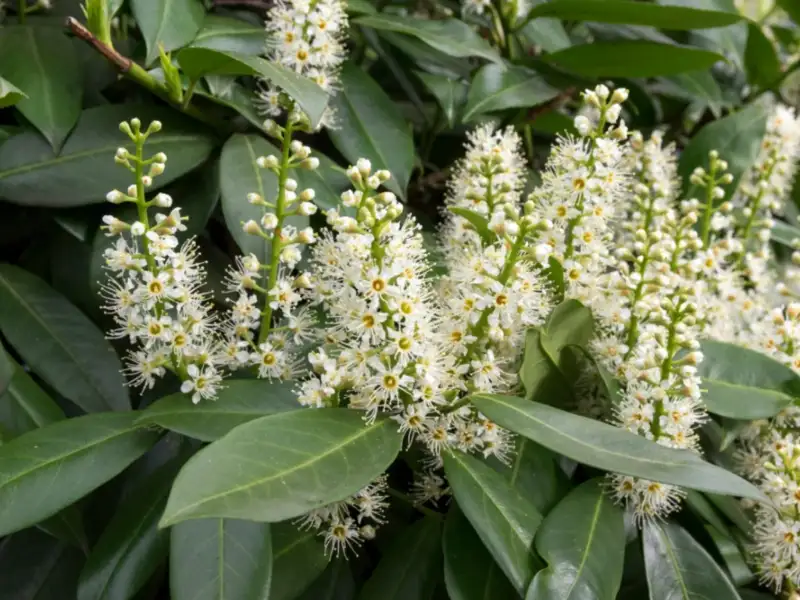
Laurel cherry is a white flowering EVERGREEN SHRUB with GLOSSY DARK GREEN leaves. This BUSHY PLANT produces white spring blooms that lend beauty and color year-round. It’s like having a LOYAL SIDEKICK in your garden – always there for you.
Its DENSE FOLIAGE also provides excellent cover for WILDLIFE. This makes it an ideal choice for NATURE LOVERS who want to attract native birds to their outdoor space. Well, at least you’ll be attracting something (just kidding).
Also, these white flowering shrubs GROW COMPACT. That means they are perfect as a STANDALONE SPECIMEN or low HEDGE.
Hardiness: USDA zones 4-5.
Light exposure: partial shade.
Blooming season: repeated from early spring to early summer.
Size: 20-40 feet tall (6– 12 m) and up to 35 feet in spread (10.6 m).
Soil requirements: well-drained, moist soil and fertile loam, clay, or sand-based soil. Need a slightly acidic pH. Keep it humid, watering regularly.
Tips
I add MULCH around the base of my plants to help them RETAIN MOISTURE. Consider pruning your Laurel Cherry in EARLY SPRING to get them to your DESIRED SIZE. They can get quite big. I also elevate my planting beds for better drainage.
6. New Jersey Tea
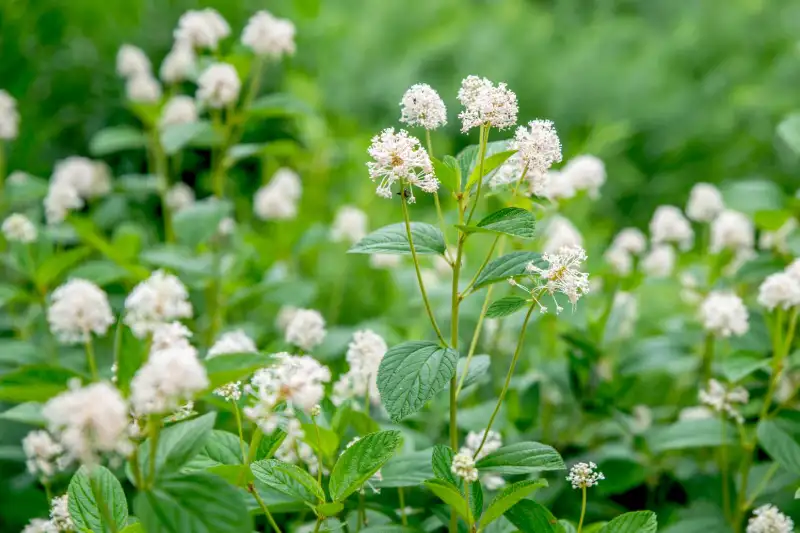
New Jersey Tea is a white flowering bush with GLOSSY DARK GREEN leaves. It starts producing flower buds EARLY in the season. Then, *poof* they turn into CREAMY-WHITE FLOWERS. Now that’s magic!
The FRAGRANT WHITE BLOOMS attract pollinators such as BEES and BUTTERFLIES each year. It’s like having your own personal buzz party (minus the hangover). Get it? Buzz.
New Jersey Tea also has MEDICINAL USES. Native Americans used its roots for treating colds, fevers, or other ailments. And you can try it too!
This DECIDUOUS SHRUB makes an attractive addition to any landscape.
Hardiness: USDA zones 5-9.
Light exposure: full sun to partial shade.
Blooming season: repeated from mid or late spring to early summer.
Size: 3 -6 feet tall (0.91 – 1.83 m) and up to 4 feet in spread (1.22 m).
Soil requirements: well-drained, moist, and fertile loam or sand-based soil. Tolerate a wide pH range but need a slightly acidic pH. Keep it humid, watering regularly.
Tips
Give your New Jersey tea at least 6 hours of FULL SUN DAILY. Also, BEFORE PLANTING, add good-quality COMPOST to help RETAIN MOISTURE.
7. Tea Olive
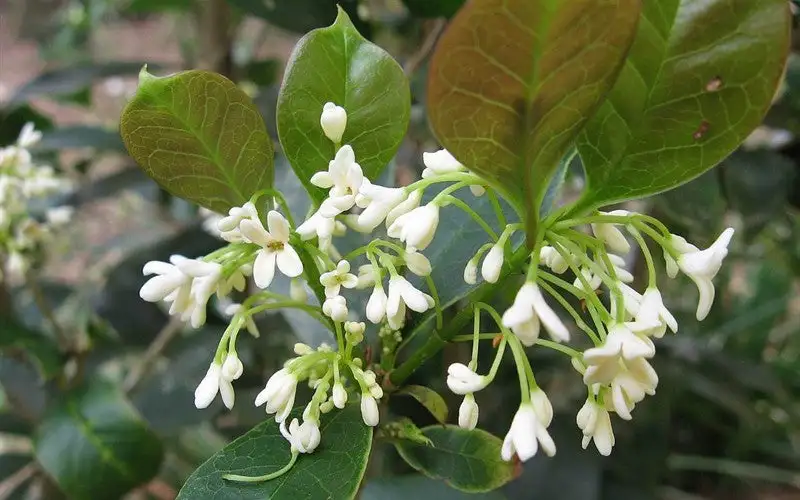
Tea Olive is an EVERGREEN SHRUB with white showy flowers. It has GLOSSY GREEN FOLIAGE all year round. It’s the James Bond of bushes – always cool, collected, and classy.
Its clusters of SMALL but INTENSELY SWEET-SMELLING FLOWERS can perfume the entire garden. Don’t worry. It doesn’t smell like Tea. Hahaha
This LOW-MAINTENANCE plant is an excellent hedge for gardens needing EXTRA HEIGHT. It grows taller than MOST guys wish they were.
Want some POOLSIDE BEAUTY without any HASSLE? The Tea Olive has got you covered too!
Hardiness: USDA zones 8b-11a.
Light exposure: full sun to partial shade
Blooming season: repeated beginning from late spring to fall.
Size: 6-30 feet tall ( 1.8-9.1m) and up to 8 feet in spread (2.4m).
Soil requirements: moist, well-drained soil and fertile loam or sand-based soil. It needs a wide pH range from neutral to acidic. Keep it humid, watering regularly.
Tips
Take extra care when TRANSPLANTING these white flowering shrubs. I plant them at the SAME DEPTH that it was growing before.
8. Spirea

Spirea is a WHITE FLOWERING SHRUB. It produces abundant CLUSTERS of tiny, white flowers. But some varieties can produce pink flowers. Plant all these together, and your garden will have a MOOD RING.
Some varieties also have VARIEGATED FOLIAGE. These plants can be habitats for birds and other wildlife around your home.
Spireas are also great additions to CASUAL PATIO SETTINGS from SPRING into AUTUMN. That makes a perfect backdrop for those BBQ parties because who doesn’t love a good OUTDOOR PARTY?
Hardiness: USDA zones 4-8.
Light exposure: full sun.
Blooming season: repeated from spring to summer.
Size: 1-8 feet tall (0.3– 2.4 m) and up to 6 feet in spread (1.8 m).
Soil requirements: Well-drained, moist, fertile loam, clay, chalk, or sand-based soil. Need a neutral to slightly acidic pH. Keep it humid, watering regularly.
Tips
Grow them at least 3 feet apart for PROPER AIRFLOW. They DON’T mind POOR SOIL, either. Just make sure it’s WELL-DRAINED.
9. Fothergilla

Fothergilla is an excellent DECIDUOUS SHRUB for any garden. This white flowering plant is SLOW GROWING, and it produces TINY FLOWERS.
They grow in clusters ON THE BRANCHES of your shrub, making them stand out during the BLOOMING SEASON. You won’t ‘foth-get’ about it easily.
Fothergilla is COLD HARDY, so it works well in cooler and warm climates. They need very LITTLE maintenance or care once planted too! Unlike INVESTING, you can set it and forget about it – NO MATTER what that guy on Facebook tells you.
Hardiness: USDA zones 5-8.
Light exposure: full to partial sun.
Blooming season: repeated from early spring to summer.
Size: 3 -5 feet tall ( 0.9-1.5 m) and up to 10 feet in spread (3m).
Soil requirements: Well-drained, moist soil and fertile loam or sand-based soil. Need a slightly acidic soil pH. Keep it humid, watering regularly.
Tips
I space my plants and prepare the soil with RICH COMPOST. Also, I place the shrubs in an area SHELTERED from STRONG WINDS, as they often damage NEW GROWTH.
10. Magnolia
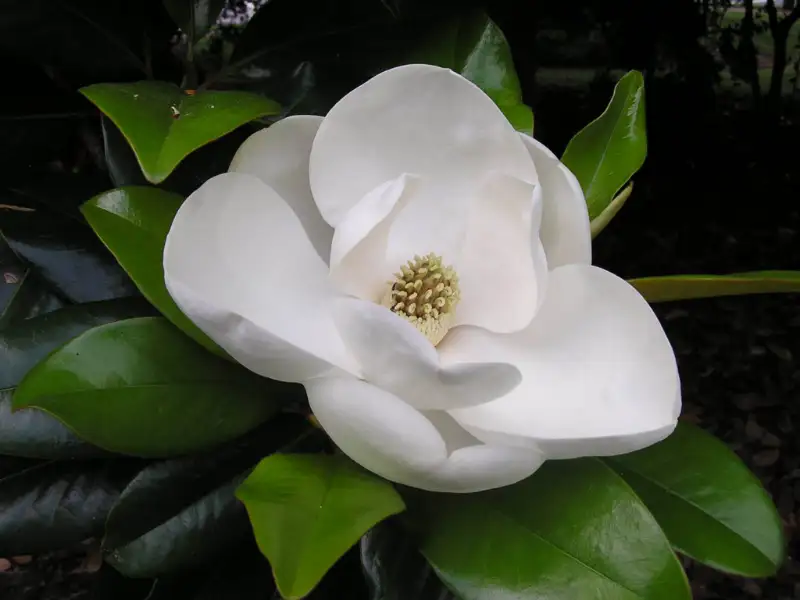
Magnolias are WHITE FLOWERING SHRUBS that produce FRAGRANT FLOWERS. Also, some blooms produce PINK FLOWERS. It is said that if you walk CLOSE ENOUGH, you can hear these regal flowers chant, ‘long live the queen!’
The plant can be a DECIDUOUS or EVERGREEN SHRUB, depending on the variety. So you can get a variety that looks good YEAR-ROUND, unlike my wardrobe.
These beauties bring STYLE and SOPHISTICATION to any garden. Plus (drum roll, please), magnolias DON’T require CONSTANT CARE! Even beginners or lazy gardeners (*raises hand*) can easily grow them.
Hardiness: USDA zones 4–8.
Light exposure: full sun to partial shade.
Blooming season: repeated from spring to summer.
Size: 10 – 15 feet tall (3 – 4.6 m) and up to 12 feet in spread (3.7 m).
Soil requirements: moist, well-drained soil and fertile loam, or sand-based soil. Need a slightly acidic pH. Keep it humid, watering regularly.
Tips
Depending on the variety, you may want to STAKE YOUNG TREES. Ensure you keep MOST of the ROOT SYSTEM when transplanting.
11. Deutzia

Deutzias, rhododendron spp, are beautiful WHITE FLOWERING SHRUBS. Its small, delicate white flowers bloom EARLY in the season.
And boy, do they smell DIVINE! It’s like walking into a French bakery, but instead of croissants, you get hit with SWEET FLORAL SCENTS.
And get this – they’re native to parts of ASIA! That makes it an excellent choice for those of you looking to add some EXOTIC BEAUTY to your space. Growing them officially makes you an international gardener! Hahaha.
You can use these bushes with white flowers as a shrub border or hedge.
Hardiness: USDA zones 5–8.
Light exposure: full sun to part sun.
Blooming season: repeated from early spring to summer.
Size: 1 – 10 feet tall (0.3 – 3 m) and up to 8 feet in spread (2.4 m).
Soil requirements: moist, well-drained soil and fertile loam or sand-based soil. Need a slightly acidic pH. Keep it humid, watering regularly.
Tips
Prune IMMEDIATELY after FLOWERING for the best results! Also, keep the CROWN slightly ABOVE the surrounding soil level when planting.
12. Pearlbush
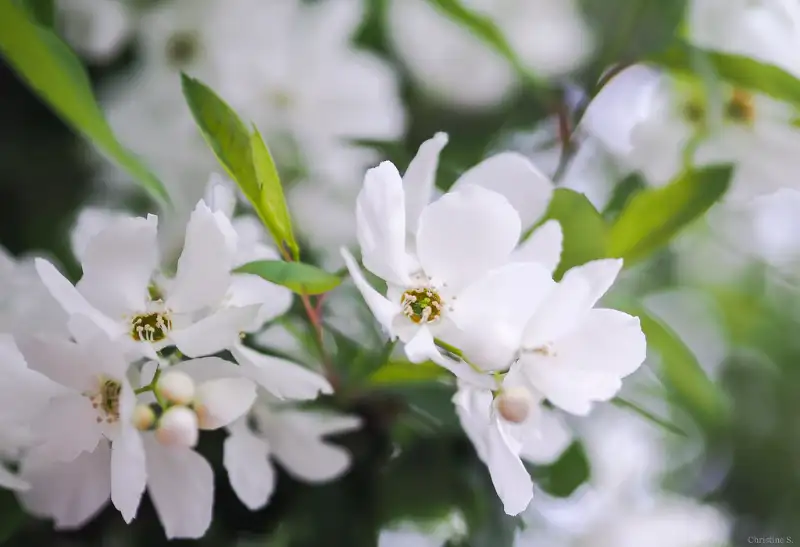
Pearlbush is a CLASSICAL BUSH. That means this plant is NOT a POPULAR GARDEN SHRUB. That’s just like the music your uncle plays at family parties.
These plants are known for their small, PURE WHITE FLOWERS that bloom early in the season.
Pearlbush’s LUSH FOLIAGE can make borders so SHARP it’ll make Edward Scissorhands jealous.
You can also use it near ENTRYWAYS and PATHWAYS. It’s like having your own personal guard dog – except MUCH PRETTIER!
And you can use it as an ORNAMENTAL ADDITION to your garden!
These white flowering bushes are CLASSIER than your ex. Just kidding, or am I?
Hardiness: USDA zones 4-8.
Light exposure: full sun or partial shade.
Blooming season: repeated from late spring.
Size: 10 – 15 feet tall (3 – 4.6 m) and up to 12 feet in spread (3.7 m).
Soil requirements: Well-drained, moist soil and fertile loam or sand-based soil. Need a slightly acidic pH. Keep it humid watering regularly.
Tips
Add some MULCH to the BASE of the shrub. It helps RETAIN MOISTURE in the soil. Also, I fertilize my Pearlbush TWICE A YEAR for the best results.
13. Mountain Laurel
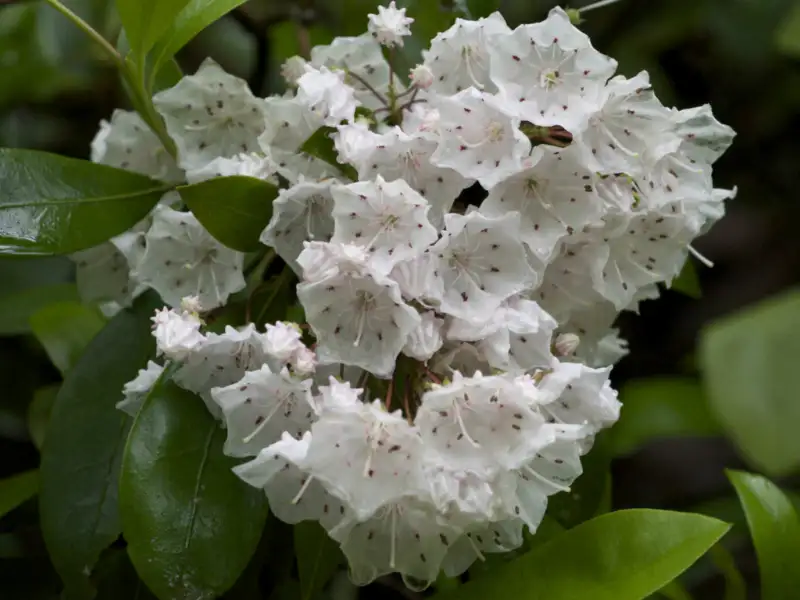
Mountain laurel is a BROADLEAF EVERGREEN SHRUB with WHITE FLOWERS and PINK BUDS. This bush Beyonce adds visual interest to your garden with FLAWLESS white or pink blooms.
And let’s talk foliage for a minute. Mountain laurels are the Energizer bunny of white flowering bushes. They have LUSH GREEN VEGETATION all year round. They remain UNFAZED by SEASONAL CHANGES in temperature or moisture.
You can use it as BORDERS and HEDGES to block out even your NOSIEST NEIGHBOR who always wants to come over for tea. [*eye roll*]
Hardiness: USDA zones 5-9.
Light exposure: partial sun to shade.
Blooming season: repeated from late spring to early summer.
Size: 5 – 15 feet tall (1.5 – 4.6 m) and up to 4 feet in spread (1.2 m).
Soil requirements: moist, well-drained, and fertile loam or sand-based soil. Need a slightly acidic pH. Keep it humid, watering regularly.
Tips
Don’t plant your Mountain laurels in HEAVY SOILS, such as clay-based soils, as they are likely to cause ROOT ROT. You can also IMPROVE the drainage in plants by using RAISED BEDS.
14. Summersweet Clethra

Summersweet Clethras is the Harry Styles of WHITE FLOWERING SHRUBS. They are stunning to look at and oh so dreamy.
I use it for its attractive and fragrant AROMA. I plant it near the entrance to my house or walkways or where visitors can enjoy the smell. Nothing says welcome quite like an INVITING SCENT!
This hardy bush is practically INDESTRUCTIBLE. It is stunning no matter what conditions you throw its way. It’s like the shrub version of a cockroach, except it looks good.
Hardiness: USDA zones 3-9.
Light exposure: full sun to partial shade.
Blooming season: repeated from mid to late summer.
Size: 3-8 feet tall (0.9 – 2.4 m) and up to 6 feet in spread (1.8 m).
Soil requirements: moist, well-drained, and fertile loam or sand-based soil. Need a slightly acidic pH. Keep it humid, watering regularly.
Tips
I plant these plants in SPRING. It does well with AVERAGE SOIL. And I prune it after it has flowered to keep it growing HEALTHY.
15. Cinquefoil White
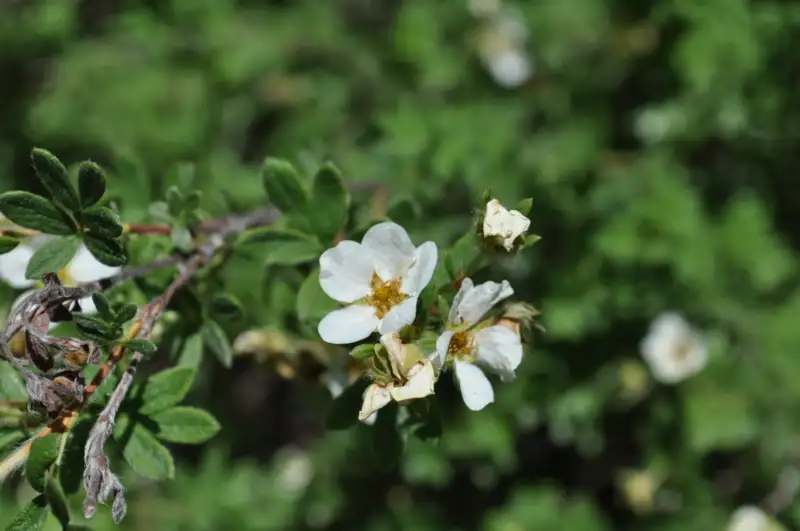
Cinquefoil White is a BEAUTIFUL BUSH with DELICATE WHITE FLOWERS.
Apart from having a name that sounds like an OBSCURE INDIE BAND, these bushes add BEAUTY to your garden.
Additionally, they attract BENEFICIAL INSECTS like bees & butterflies. You know what that means. You get free NATURE VIBES and POLLINATION for your plants.
These RESILIENT BUSHES make great borders for large or small garden spaces.
Their bright white color COMPLEMENTS OTHER PLANTS. Just plant a mix of several shrub varieties together to get an eye-catching feature!
Hardiness: USDA zones 5–8.
Light exposure: full sun to partial shade.
Blooming season: repeated from spring to summer.
Size: 3-5 inches tall (7-12 cm) and up to 12 inches in spread (30 cm).
Soil requirements: moist, well-drained soil and fertile loam, clay, or sand-based soil. Need a slightly alkaline pH. Keep it humid, watering regularly.
Tips
DEADHEAD FADED FLOWERS to encourage more blooms throughout the season. Always keep the roots moist when TRANSPLANTING them. If the roots dry up while in transit, the plant may die.
16. White Hibiscus

White Hibiscus is a beautiful WHITE FLOWERING EVERGREEN shrub with LARGE FLOWERS. The lush foliage provides an attractive backdrop to the blooms throughout the year.
This plant is EASY MAINTENANCE. That’s due to its HARDINESS and ability to handle MANY soil conditions. That’s kinda like how Dwayne “The Rock” Johnson handles action movies with ease.
You can use it as a SPECIMEN in MIXED FLOWER BEDS or plant along paths or walkways. It’s like a PERSONAL ASSISTANT on duty to bring charm to your garden without the high salary.
Hardiness: USDA zones 5–9.
Light exposure: full sun.
Blooming season: repeated from early summer to fall.
Size: 3 – 6 feet tall (0.9 – 1.8 m) and up to 3 feet in spread (0.9 m).
Soil requirements: moist, well-drained soil and fertile loam, or sand-based soil. Need a slightly acidic to alkaline pH. Keep it humid, watering regularly.
Tips
When pruning, I DO NOT remove over ONE-THIRD of the existing foliage. Always plant your White Hibiscus 3-6 feet apart to help them GROW WELL.
FAQs about White Flowering Bush
1. What white flower bush smells like vanilla?
Sweet autumn clematises are bushes with white flowers that have a vanilla-like scent. Its star-shaped flowers bloom during the late summer and autumn. This results in sweet-smelling white blooms where they are planted.
The plant is quite easy to grow. And it tolerates different kinds of soil conditions and sun or shade exposure. Don’t let the vanilla-like scent fool you, it’s not edible.
2. What shrub has white flowers in spring and red berries in fall?
Linden viburnum is a shrub that blooms with fragrant white flowers in the spring. And this viburnum produces bright red berries in the fall. It can reach heights of 8 – 10 feet, has a rounded form, and is best grown as a specimen plant or massed together for privacy.
The glossy green foliage turns yellow-bronze in autumn. That’s before it sheds its leaves each winter.
3. Do spirea bushes attract bees?
Yes, spirea bushes can attract bees. Spireas produce tiny white or pink flowers from spring to summer. And these blooms are attractive to many pollinators, including honeybees. The flowers produce nectar, a sweet treat highly appealing to bees.
Additionally, some species of spireas have fragrant scents which can lure in honeybees. Also, hummingbirds and other beneficial insects, such as butterflies, visit Spirea bushes.
4. Are there different types of spirea bushes?
Yes, there are different types of spirea bushes. There are estimated to be between 10 and 90 species of this bush. They are mostly spring or summer blooming. Popular examples include goldflame spirea and snowmound spirea.
What’s Next
We discussed 16 white flowering bushes with awe and curiosity. From the size, and hardiness to the characteristics of these plants – we shared all details about them!
Soil requirements? Checked. Appearance? Definitely checked off too! We had a great time diving deep into this world of beauty and wonderment these little white blooms have given us.
Ready to add some stunning white flowering bushes to your garden? Check out our website at Astergardening for the details you need on these plants and more.
We have detailed information to upgrade your gardening skills and landscape aesthetics. So get ready for a world of beauty in your own backyard! Visit us today!
